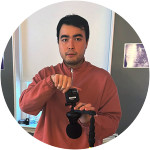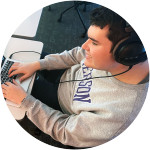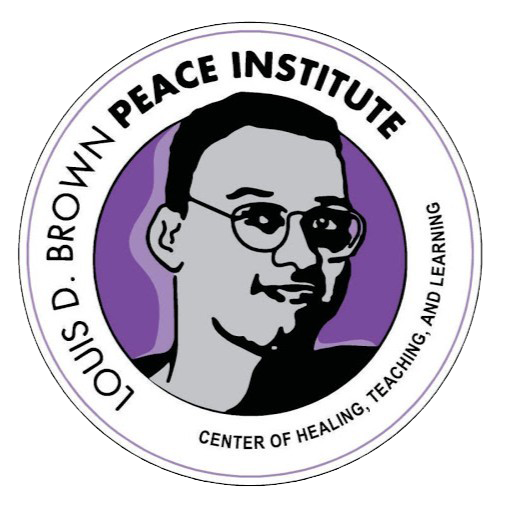Immersive Media: Co-Design for Peace in Boston
In this immersive media Social Impact Studio (VM495), students will be introduced to the fundamentals of Virtual Reality and/or 360 Video production and explore how to tell stories and create experiences in immersive media environments that inspire people to action.
CHOOSE A SEMESTER TO EXPLORE:
Course Information
DEPARTMENT(S):
Visual & Media Arts
PROFESSOR:
David Kelleher
PARTNER ORGANIZATION: Louis D. Brown Peace Institute
LEARNING PARTNERS:
Taylor Lee, Maudrie Depradine, Lois Frazier, Janice McCoy, Janice V Johnson
The course involved the direct participation of survivors of gun violence, as co-designers of virtual reality media experiences. Students worked on project teams with family members who lost loved ones to gun violence to create immersive experiences for healing and empowerment.

A Look Inside the Co-Creation Process
“My goals have changed from simply ‘getting the work done’ to ‘make the project as best as it possibly can be.’ I feel much more invested in bringing our community’s stories to the world.”
— Peter Travis, student
INTRODUCTIONS
During the first week of class, students met the Engagement Lab staff, Louis D. Brown Peace Institute staff, and community survivors. Five participants performed an immersive storytelling workshop, featuring improvised spoken word with video backgrounds and looping music beats. Participants shared stories from their pasts, moments of inspiration and joy in our lives, and amazing poetry.
FIRST VISIT TO THE PEACE INSTITUTE
In the third week of class, the students visited the Louis D. Brown Peace Institute to learn about Peace Play in Urban Settings, a healing activity designed to support survivors of violence. Students and survivors worked together to share stories on a sand tray using miniatures representing various elements of life, and shared stories together, which was a very emotional experience for everyone. Through the activity, students and learning partners gained a better understanding of each other, and began to consider creating a virtual Peace Play experience as a goal for the semester.
This week, the learning partners also got to try out an interactive VR experience called The Key, which tells the story of refugee immigrants who cannot return home, despite keeping the keys to their old homes. This is an excellent example of trauma informed storytelling, and included elements which informed the class’s work, such as immersive storytelling and the importance of symbolic objects, similar to the miniatures featured in the Peace Play activity.
SECOND VISIT TO THE PEACE INSTITUTE
About a month into the semester, the class once again visited the Louis D. Brown Peace Institute, and this time Learning Partners Maudrie and Janice tried out the Virtual Reality headsets for the first time. “It was pretty cool,” reported Maudrie. “You feel like you’re right there.”
At this visit, the students presented their ideas for the final project to the community members, proposing an adaptation of the Peace Play technique into virtual reality. This brought some trepidation from the Learning Partners, who were skeptical that a virtual reality experience could have the same impact that a hands-on experience could, and affirmed the importance of incorporating true stories, rather than fictional ones. At the same time, by the end of the session, the partners were cautiously optimistic about the project: Learning Partner Janice felt that for someone who hadn’t experienced gun violence, being immersed in a survivor’s true story could bring a new understanding.
BUILDING A VR APPLICATION
Having identified their respective skills at the beginning of the semester, the Emerson students used this information to select volunteers to lead the different areas of design and production needed for the project, and to identify others to assist with each task. These areas included story, music, production, and sandbox design.
Following the guidance of the learning partners, the class decided to translate Peace Play into virtual reality by building a 360 beachscape from which the user could select various 3D objects, each of which held specific significance to Janice McCoy, a learning partner and member of the Peace Institute’s survivors network, whose son Raheem was murdered in 2018. Janice recorded a voiceover narrating the story of her own healing journey, which was incorporated into the application along with peaceful music.
SHARING A PROTOTYPE
The students presented a prototype to the learning partners and other members of the Peace Institute staff before Thanksgiving break.
Chaplain Clementina Chéry, the Peace Institute’s founder, advised the students to incorporate additional information about the objects, why Janice chose each, and what they mean to her specifically. “I think this was a great learning opportunity for me and the other students,” said Tamara Hamdalla, one of the students. “I am very thankful that Clementina had that insight, as I wouldn’t have thought of that, and I think it furthers the project significantly.”
“Since our project is about, and for the community we are working with, their feedback is invaluable to our work. I think any and all of the feedback they gave for all different aspects of the project should be used to reconsider and revise it and make this the best version we can make it.”
— Tamara Hamdalla, student
FINAL REFLECTIONS
On December 8, students and learning partners presented their work at a "Peace in Process" community event in Dorchester, alongside participants from the Social Impact Studio in Game Design, partners from Massachusetts General Hospital and Teen Empowerment, and other members of the community, who tried the VR experience in small groups. The Studio participants were encouraged by the praise and high ratings, averaging 8.5 on a scale of 10, for the healing potential of the project. Hearing stories about intergenerational bonding over the experience was especially rewarding.
Some feedback about the VR experience:
- Good experience (Massachusetts General Hospital partner)
- Fun and engaging (Teen Empowerment partner)
- Objectives could be more clear (Teen Empowerment partner)
- Some objects hard to manipulate (Teen Empowerment partner)
- Make it more accessible for people with low vision (Survivor)
- Could not see all spawned objects, some fell through sand (Emerson students)
- I love it! (Community member)
“I was proud of our work, and cannot express how gratifying it is knowing my project was enjoyed by the survivors.”
— Tomas Lorenzo Macasaet, student
Fall 2022 - Immersive Media Studio Projects
Fall 2022 - Immersive Media Studio Participants
Students

Tamara Hamdalla
Visual & Media Arts '24

Tomas Lorenzo Macasaet
Visual & Media Arts '25

Jingyi Mao
Consortium Student, Berklee College of Music

Arman Mukhtaruly
Student, Emerson College

Juliana Perez
Visual & Media Arts '23

Kaila Shugars
Visual & Media Arts '25

Peter Travis
Studio Assistant; Visual & Media Arts '25
Learning Partners

Maudrie Depradine
Learning Partner

Lois Frazier
Learning Partner

Janice V Johnson
Learning Partner

Taylor Lee
Learning Partner

Janice McCoy
Learning Partner
Studio Professors

David Kelleher
Senior Affiliated Faculty, Visual & Media Arts
Studio Contact
Are you an Emerson student interested in enrolling in this course in the future? Please contact david_kelleher@emerson.edu to learn more!

